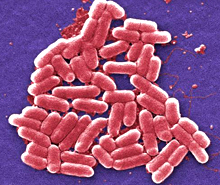Scientists Recode Organism’s Genome
Scientists Recode Organism’s Genome
Researchers developed a method to engineer a bacterium’s genome to create new genetic codes. The technique has the potential to turn microbes into efficient living factories that can make novel compounds.

Escherichia coli. Image by Janice Haney Carr, courtesy of CDC.
When proteins are made, the genetic code contained in DNA is transcribed into a closely related molecule called RNA. The RNA then serves as a template to make a protein.
Each set of 3 DNA bases, called a codon, directs the cell’s machinery to add a specific amino acid to a growing protein chain. However, different codons can code for the same amino acid. For example, GCA, GCC, GCG, and GCT all direct different parts of the cell’s machinery to add the same amino acid, alanine. Similarly, UAG, UAA, and UGA are all RNA “stop” codons. Each recruits different machinery to stop the production of a protein once the amino acid chain is complete.
A team led by Dr. George Church of Harvard Medical School and Dr. Farren Isaacs of the Yale School of Medicine set out to recode the Escherichia coligenome to allow it to incorporate a synthetic non-standard amino acid (NSAA) into its protein structures. This approach would allow the bacteria to make new materials. The work was funded in part by NIH’s National Institute of Diabetes and Digestive and Kidney Diseases (NIDDK), National Institute of General Medical Sciences (NIGMS), and an NIH Director’s Early Independence Award. Results appeared in the October 18, 2013, issue ofScience.
In this proof-of-concept study, the researchers repurposed the UAG stop codon. First, they switched all instances of UAG in the genome to another stop codon, UAA. This ensured that protein production would still end at the appropriate points and allow the cell to function normally. They then removed the stop machinery associated with UAG from the cell. Finally, they introduced genetically engineered components (aminoacyl–tRNA synthetase and tRNA) that reassigned UAG to direct the cell to incorporate NSAAs into amino acid chains.
To test the genomically recoded organism (GRO), the scientists included UAG codons in the sequence for a green fluorescent protein. They found that the GROs successfully incorporated NSAAs into the proteins.
Removing the stop machinery associated with UAG codons didn’t impair the GRO’s ability to reproduce. The GROs also showed increased resistance to a type of virus that infects bacteria. It’s possible that new genetic codes may protect cells by causing errors when viral proteins are translated.
The creation of a GRO raises the possibility that researchers might be able to retool nature and create new forms of proteins. In an accompanying study, the Harvard group showed that the approach may be feasible for several other codons in the genome as well.
“Since the genetic code is universal, it raises the prospect of recoding genomes of other organisms,” Isaacs says. “This has tremendous implications in the biotechnology industry and could open entirely new avenues of research and applications.”
By Katherine Wendelsdorf, Ph.D.
###
* The above story is reprinted from materials provided by National Institutes of Health (NIH)
** The National Institutes of Health (NIH) , a part of the U.S. Department of Health and Human Services, is the nation’s medical research agency—making important discoveries that improve health and save lives. The National Institutes of Health is made up of 27 different components called Institutes and Centers. Each has its own specific research agenda. All but three of these components receive their funding directly from Congress, and administrate their own budgets.




















